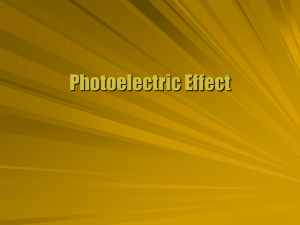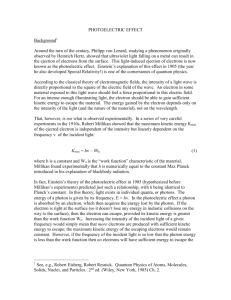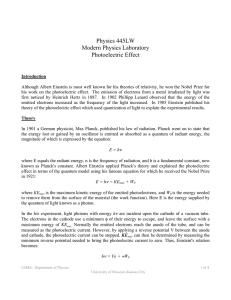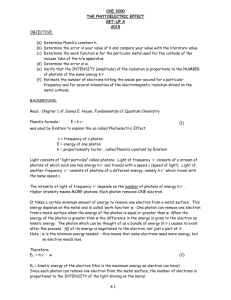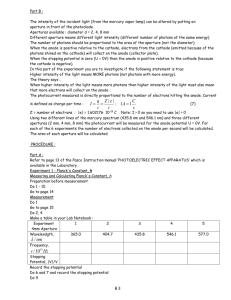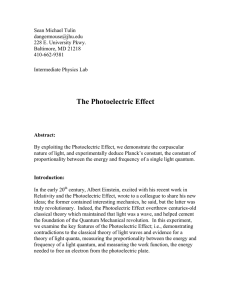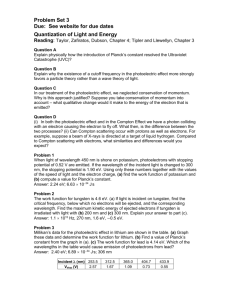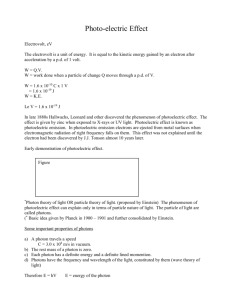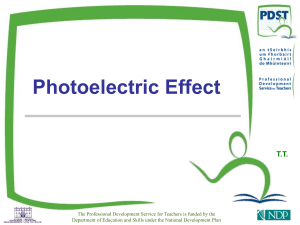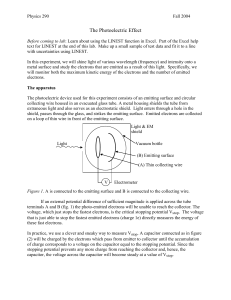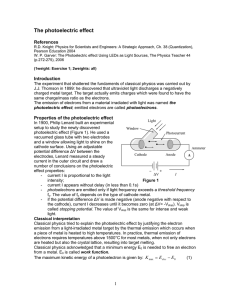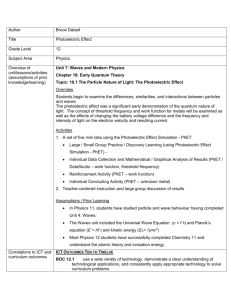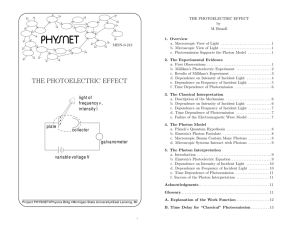The Photoelectric Effect: Pre-Lab
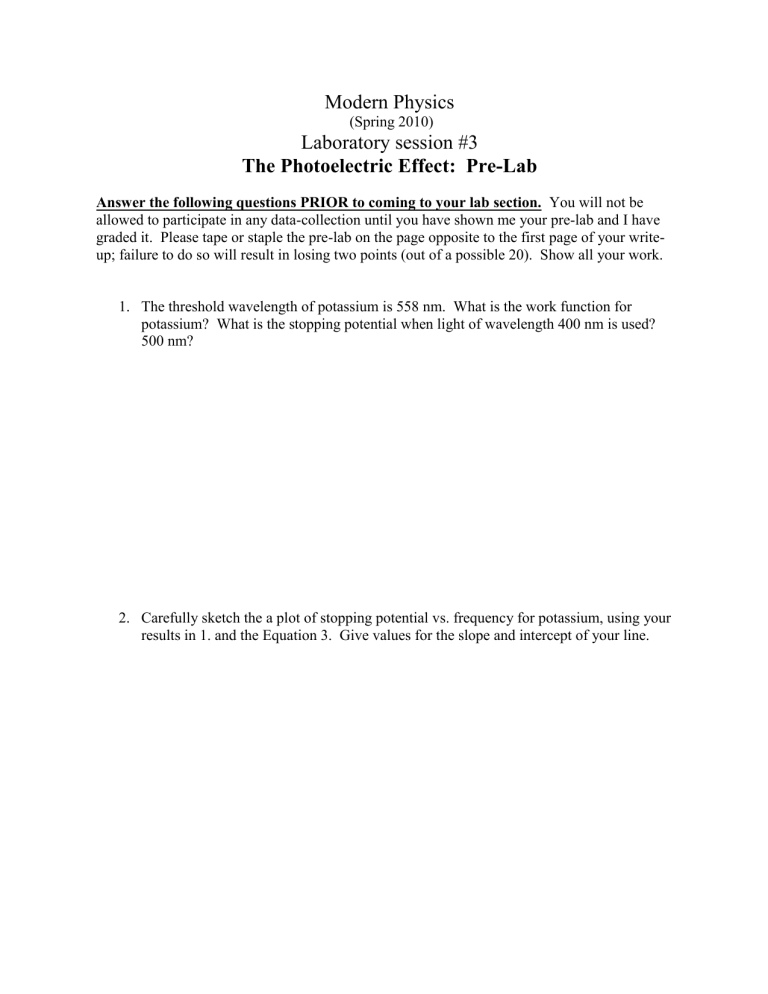
Modern Physics
(Spring 2010)
Laboratory session #3
The Photoelectric Effect: Pre-Lab
Answer the following questions PRIOR to coming to your lab section.
You will not be allowed to participate in any data-collection until you have shown me your pre-lab and I have graded it. Please tape or staple the pre-lab on the page opposite to the first page of your writeup; failure to do so will result in losing two points (out of a possible 20). Show all your work.
1.
The threshold wavelength of potassium is 558 nm. What is the work function for potassium? What is the stopping potential when light of wavelength 400 nm is used?
500 nm?
2.
Carefully sketch the a plot of stopping potential vs. frequency for potassium, using your results in 1. and the Equation 3. Give values for the slope and intercept of your line.
Physics 160 Laboratory, Spring 2010
Session 3: The Photoelectric Effect
2
Modern Physics
(Spring 2010)
Laboratory session #3
The Photoelectric Effect (h/e)
Objective:
To verify Einstein’s photon explanation of the photoelectric effect.
Background:
In 1905 Albert Einstein proposed a model of the photoelectric effect as the absorption of photons by electrons in the surface of a metal. The photon is a bundle of light with energy proportional to its frequency, E
hf where h is Planck's constant and f is the frequency of the light. An electron receives the energy of one photon (two photon absorption being MUCH less likely). Since the electron is bound in the surface of a material, some of the acquired energy
( W ) goes into liberating the electron from the surface. (Perhaps, it is not too surprising that an
0 electron needs to overcome some energy barrier to leave a solid since a charged object remains so under normal circumstances.) The remainder of the absorbed photons energy shows up as the electron's kinetic energy as it leaves the surface. Some electrons are more tightly bound to the surface than others are and the work function actually represents the smallest amount of energy that is required to liberate the electron from the surface. The above description is summarized by the equation,
KE max
hf
W
0
. (1)
If the electron finds itself in an electric field (directed away from the surface), the kinetic energy will be converted to electric potential energy. Electrons, which leave the surface with the maximum KE, can ultimately reach a location where their electric potential energy is,
PE
eV o
KE max
, (2) where V is the stopping potential and the last equality makes use of the conservation of energy.
0
We can therefore rewrite the Eq. 1 in terms of the stopping potential, i.e. the potential that when applied to an electrode near the emitting surface will send all electrons "falling" back onto the surface,
V
0
h e f
W
0 e
. (3)
Physics 160 Laboratory, Spring 2010
Session 3: The Photoelectric Effect
3
In this experiment you will use five visible light colors (i.e. frequencies) to verify Eq. 3 and in the process obtain a value for the ratio of Planck's constant to the fundamental electric charge, and the work function for the emitting material. You will also be able to control the intensity of the incident light using a sequence of "neutral density" filters to investigate the dependence of the stopping potential on light intensity.
Apparatus:
The apparatus consists of a mercury vapor lamp, a diffraction grating, 3 filter slides, a cathode, an anode that is shielded from stray light, a high-impedance, unity gain amplifier, and a digital voltmeter. e -
Fig. 1 A portion of the apparatus
The photons are generated via a mercury vapor lamp which emits a characteristic set of visible wavelengths or frequencies of light:
Yellow
Green
Blue
Violet
Ultraviolet
5.18672x10
14
Hz
5.48996x10
14
Hz
6.87858x10
14 Hz
7.40858x10
14
Hz
8.20264x10
14
Hz
The diffraction grating disperses the light from the lamp, sending each of the colors out in different directions. This effect relies on the interference coming from multiple sources of light.
The formula for constructive interference is the same as 2-slit interference result. d sin
m
This effect will also be used in future lab sessions to measure the wavelengths of light emitted by hydrogen gas.
Physics 160 Laboratory, Spring 2010
Session 3: The Photoelectric Effect
4
The cathode and anode are mounted on a unit that can be positioned to permit only one color from the mercury lamp at a time to be incident on the cathode. You will need the filters to block stray light for the yellow and green lines.
In this experiment we do not control the potential between the emitting and collecting electrodes.
Instead the emitted electrons charge up the collecting electrode and the amplifier circuit connected to the digital voltmeter permits measurement of the potential to which the collecting electrode has charged. Photoelectrons emitted from the photocathode will continue to charge up to collecting electrode until its potential reaches the stopping potential. Therefore, the final voltage reading represents the stopping potential.
Instead of a simple voltmeter, we put in a high-impedance, unity gain amplifier. High impedance is a fancy way of saying that the anode will discharge very slowly. Unity gain implies that the output voltage is the same as the input voltage so that we are actually reading the stopping potential.
There are two colored filter slides. Use these filters over the entrance to the photodiode when you are looking at the yellow and green frequencies respectively to cut out extra light from the room that will corrupt your measurements. The third slide has a sequence of increasingly dense
"neutral density filters" which you will use to control the incident light intensity.
Suggested directions for the investigations:
Consider each question below a mini-experiment: formulate a hypothesis (be as quantitative as possible), construct a procedure for testing it, and gather enough quantitative evidence to support a conclusion. Since there are some subtleties in the use of the apparatus, be sure to run your ideas by the instructor or the lab assistant before getting too far into them. In addition to the usual conclusions (principal findings, error analysis, assessment of experiments, etc.), consider how a 19 th
-century physicist might have reacted to your results, and whether they are consistent with the photon theory of light.
1.
The diffraction grating splits up lines into different m values. It is possible to have an m
1 line of one color overlap with an m
2 line of another color. Would you expect an m=1 UV line to overlap with an m=2 red line or vice-versa? Which do you need to worry about, red light ruining your UV measurement or UV light ruining your red measurement?
2.
What is / from your measurements? Given that number, what do you obtain for
Planck's constant? Express your answer in eV-s and J-s (for the latter, you will need the value of e = 1.602 x 10
-19
C). Is your frequency dependence in agreement with Einstein's model of the photoelectric effect?
3.
What is the work function for the emitting material from your measurements? Be sure to calculate an uncertainty for this quantity. What is the lowest frequency light (i.e. the critical frequency) that would result in photoelectron emission from this surface? What wavelength does that frequency correspond to? What color?
Physics 160 Laboratory, Spring 2010
Session 3: The Photoelectric Effect
5
4.
Does the stopping potential depend on the incident light intensity? (Hint: how do you think Einstein would interpret intensity?) Note: This might not exactly fit your expectations. If it doesn’t, what other effects might need to be taken into account?
5.
Does the rate at which electrons are emitted from the surface (i.e. the photoelectron emission current) depend on the incident light intensity? (How is the charging time related to the light intensity?)
